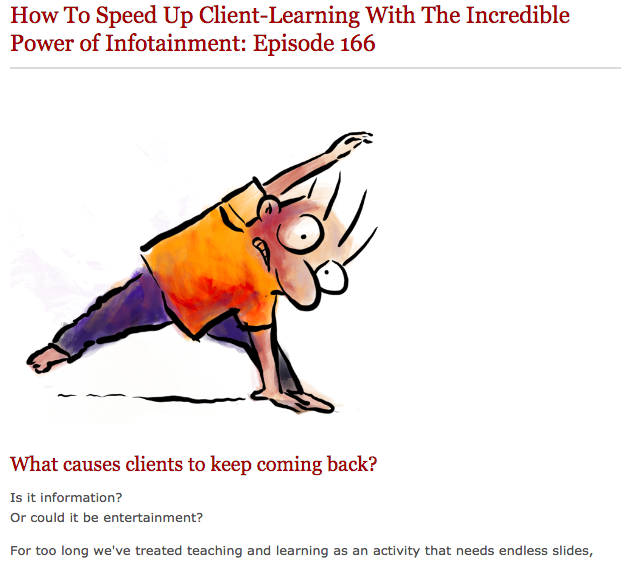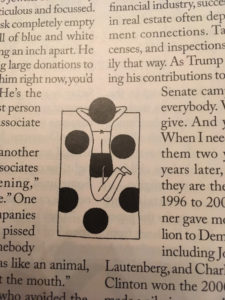Right now, I am writing a book that I will sell through my essential oils site.
I know the subject matter very well, and I could drone on about it even if somebody slapped me awake in the dead of night.
But it’s boring to just hear lots of facts and warnings and instructions, and I worry that my book will turn out dull. Since I want people to actually read this book and to get something out of it, I have to make it fun as well as informative.
Enter infotainment: entertainment combined with information. It’s something I first heard about from email marketing headmaster Ben Settle. So for your benefit as well as mine, here are 7 different types of infotainment you can stuff to make your dry-as-dust information product more exciting:
1. Cartoons
Cartoons. Every few pages. They can be used to add some color, to lighten the mood, and to reinforce a point.
New Zealand marketing guru Sean D’Souza is a master of this. Here’s an example from one of Sean’s articles on infotainment:

2. Vignettes
The New Yroker magazine does this.
Vignettes are like cartoons, but they are smaller, spread over multiple pages, and not directly connected to the surrounding text. Here’s a couple of examples from the Aug. 22, 2016 issue:


3. Stories
Stories stick. They make otherwise boring content interesting. Plus they are fun to read.
I kick off my essential oils book by telling the true story of a 2-year-old boy who got burned in a fire, how his mom used essential oils to help his wounds heal more quickly, and how the surgeons marveled and approved from the sidelines. It’s a great story, and it illustrates the power of essential oils way better than arguing with statistics or hand-waving about anti-inflammatory molecules.
4. Fun break
If you read some of the sales letters by Gary “greatest living copywriter” Bencivenga, you will frequently come across sidebars.
Just like in a magazine, these sidebars serve as a fun break, a chance to talk about something interesting, and to draw attention to it.
For example, in the book I’m writing, while talking about different proven health benefits of lavender essential oil, I have a sidebar that talks about four entirely different locations around the world where lavender is grown.
And I include some local color. One of the places has a mysterious monument that a crusader supposedly set up. Another is a kind of Shangri-La, with perfect weather on an otherwise rainy and cold mountain. A third served as a prison for the last monarch of the Austro-Hungarian empire.
5. Images
Like cartoons. Images are best when they are both relevant and surprising, beautiful and informative. Kind of like the vignettes I included above.
6. Word fun
This is an area where Ben Settle shines. His emails are fun to read, and one of the big reasons why is all the creative and colorful and unexpected language he uses.
Plus they sound super-conversational. In fact, they are more conversational than real conversation.
Poet Anthony Madrid, who writes for the Paris Review, is also a past master at this. Here’s an example:
We take the phrase “once upon a time” for granted, but if you think about it, it’s quite oddball English. Upon a time—? That’s just a strange construction. It would be pleasant to know its history: When, more or less, does it get up on its legs? Around when does it become standard procedure? My researches into this question, however, have yielded nothing conclusive.
7. Analogies
Analogies are like stories: they make boring or preachy content palatable.
A few weeks back, I was working on a probiotics sales page, and I compared probiotics you can buy at the store to mystery meat in a rusty can. For the essential oils book, I’m planning on doing something similar, I just haven’t figured out yet what dangerous-but-familiar image to compare mommy blogs to.
So there you go. 7 ways to infotain. They are formulaic. They are mercenary. And they workses.
